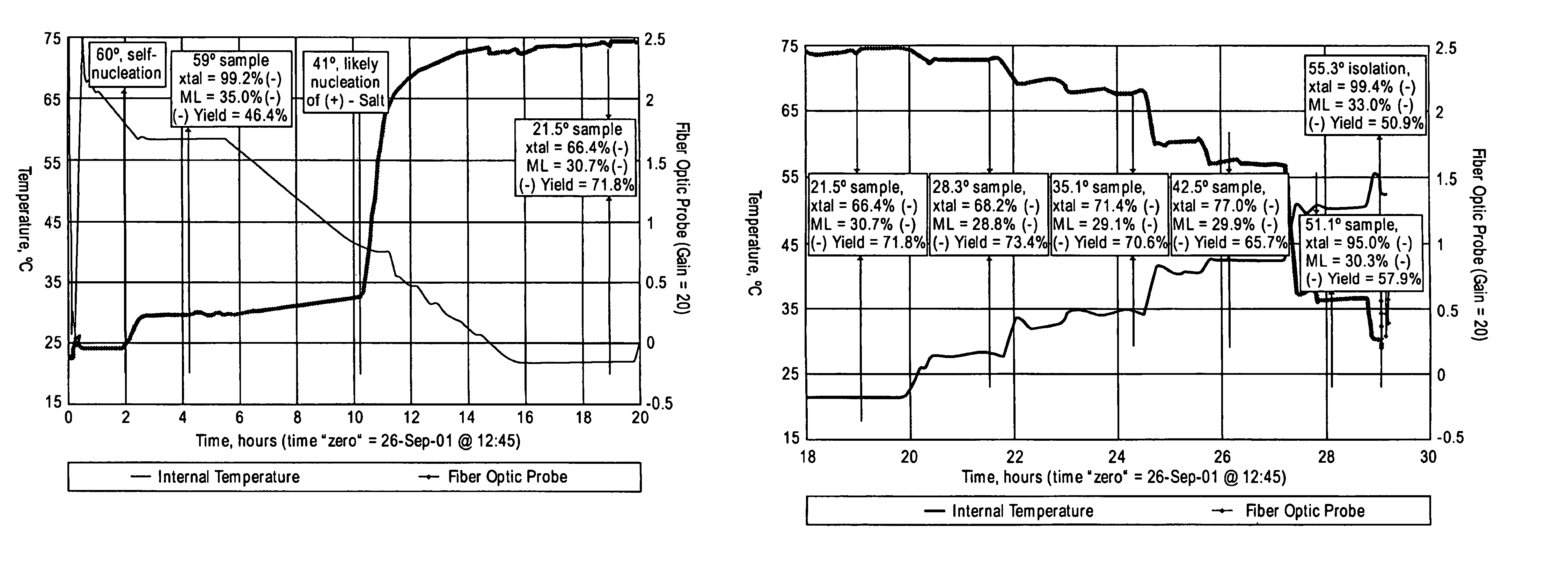Resolution of alpha-(phenoxy)phenylacetic acid derivatives
a technology of phenoxy and phenylacetic acid, which is applied in the field of enantioselective resolution process, can solve the problems of drug metabolism change mediated by inhibition of cytochrome p450 enzyme, high potential to precipitate significant adverse effects in patients, and variety of drug interaction problems, and achieve the effect of increasing the yield of the first enantiomer acid-base sal
- Summary
- Abstract
- Description
- Claims
- Application Information
AI Technical Summary
Benefits of technology
Problems solved by technology
Method used
Image
Examples
example 1
[0108]Previous resolution of CPTA has been reported in U.S. Pat. No. 3,517,050, in which cinchonidine was used as the chiral base, and the (+)-enantiomer of CPTA precipitated as the diastereomeric salt. One major drawback to this procedure was that the desired (−)-enantiomer remained in the mother liquor, making separation of a pure (−)-enantiomer fraction difficult.
[0109]This example shows the results of resolving a racemic mixture of CPTA using a variety of different chiral bases to obtain a solid enantiomerically enriched (−)-isomer. Unlike the previous method, methods of the present invention allow the solid enantiomerically enriched (−)-CPTA to be readily isolated from the solution.
[0110]Racemic CPTA was prepared by the potassium hydroxide hydrolysis of racemic halofenate. For chiral base screening, equal molar mixtures of CPTA and the chiral base were mixed in ethanol, methanol and acetone in glass vials, and the solutions were allowed to stand undisturbed. After holding overn...
example 2
[0116]This example shows the results of resolving CPTA with CAF D base in ethanol and 2-propanol.
[0117]The results for ethanol and 2-propanol are summarized in Table 3 below. For this evaluation, the slurries were sampled at various points in the cooling profile, and the enantiomeric composition of both the solid and solution phases determined. From this information, the % ee of the solid phase and expected weight percent yield (maximum 50% yield with 100% ee), calculated from the isomer ratio, were determined. Included in Table 3 is the yield of (−)-CPTA, which is derived from the weight percent yield and the (−)-CPTA content of the solid phase (maximum 100% yield with 100% ee).
[0118]In this particular study, the best results in ethanol used 1 mole of CAF D Base per mole of CPTA. Approximately 72% yield of the (−)-CPTA CAF D Base salt was calculated from the chiral composition of both phases, with an 87.6% ee of the (−)-CPTA salt in the solid phase. Use of one molar equivalent of C...
example 3
[0124]This example illustrates the solubility profiles of CAF D Base salt of (+)- and (−)-isomers of CPTA in 2-propanol.
[0125]To aid in optimization of the CPTA resolution using CAF D Base, the solubility profiles of both of the diastereomeric salts in 2-propanol were determined. The results are shown in FIG. 1. The (+)-CPTA CAF D Base salt was prepared using cinchonidine-resolved (+)-CPTA. As FIG. 1 shows, the desired (−)-CPTA diastereomer is approximately three times less soluble than the (+)-CPTA form. Equations describing the solubilities included in the figure were calculated by least squares analysis (R2>0.99). The data point for the (−)-CPTA salt at 82° C. was not included in determining the equation, but closely fits the calculated solubility.
[0126]Racemization of the undesired CPTA enantiomer could be recycled back into the process. Thus, it was found that heating an enantiomerically enriched undesired isomer of CPTA in 1 N aqueous sodium hydroxide at reflux resulted in rac...
PUM
| Property | Measurement | Unit |
|---|---|---|
| enantiomeric excess | aaaaa | aaaaa |
| enantiomeric excess | aaaaa | aaaaa |
| enantiomeric excess | aaaaa | aaaaa |
Abstract
Description
Claims
Application Information
 Login to View More
Login to View More - R&D
- Intellectual Property
- Life Sciences
- Materials
- Tech Scout
- Unparalleled Data Quality
- Higher Quality Content
- 60% Fewer Hallucinations
Browse by: Latest US Patents, China's latest patents, Technical Efficacy Thesaurus, Application Domain, Technology Topic, Popular Technical Reports.
© 2025 PatSnap. All rights reserved.Legal|Privacy policy|Modern Slavery Act Transparency Statement|Sitemap|About US| Contact US: help@patsnap.com



